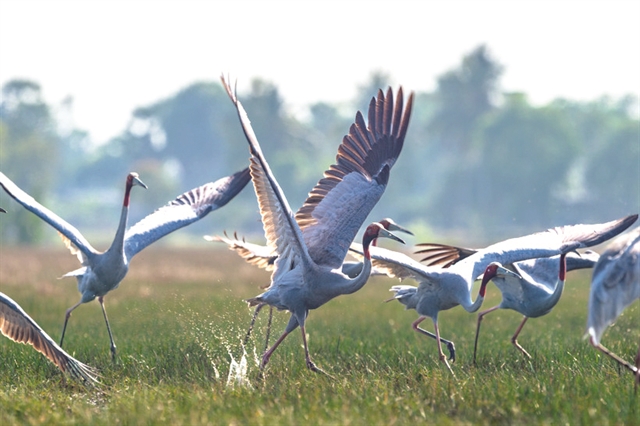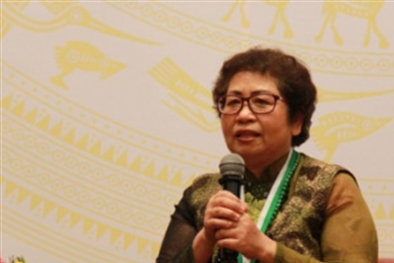 Inner Sanctum
Inner Sanctum

Associate Professor Dr Đặng Thị Cẩm Hà, a former chief of the Environmental Biotechnology Department at the Institute of Biotechnology, was given the 2015 Kovalevskaya award for her research on environmental protection, particularly technology to clean up oil contamination and treat soil contaminated by dioxin. She spoke with Việt Nam News.
 |
| Dr Đặng Thị Cẩm Hà |
Associate Professor Dr Đặng Thị Cẩm Hà, a former chief of the Environmental Biotechnology Department of the Institute of Biotechnology, was honoured with the 2015 Kovalevskaya for her research on environmental protection, particularly technologies to clean oil contamination in different ecological environments, and technologies to treat soil contaminated by dioxin-containing herbicides. She talks with Việt Nam News.
Inner Sanctum: You have researched and joined many scientific projects and received numerous national and international prizes and awards. Which is the project that interested you the most?
Among nearly 150 scientific and technological projects done by me, I was very interested in the project where technologies can treat the soil contaminated by dioxin-containing herbicides and bioremediation.
Although the war ended more than 40 years ago, a lot of areas in Việt Nam still show the after-effects of dioxin. Among them are Phù Cát, Biên Hoà and Đà Nẵng airports. These places have reported the highest polluted of dioxin in the world.
My colleagues and I at the Việt Nam Academy of Science and Technology (VAST) started a project to deal with the dioxin since 1999. We have made 12 different schemes and programmes on the project.
In 2009, our bioremediation technologies were applied at Biên Hoà Airport. After 27 months the dioxin content reduced from 10,000ng TEQ/kg of dried soil to 52ng TEQ/kg of dried soil.
These results were tested and analysed at laboratories in the Netherlands, Germany and Việt Nam’s Ministry of Natural Resources and Environment.
Despite that, we continued to promote our efforts. Forty months later, the State Independent Council announced that the figures had come down from 52ng TEQ to 14.12ng TEQ/kg as compared with the permissible figure of 40ng TEQ/kg).
This meant the soil was free from dioxin and could now be cultivated as agricultural land.
Later, we worked on Đà Nẵng Airport, reducing the toxicity to 30 per cent after six months of treatment.
Inner Sanctum: How did you discover such effective technologies? How did you protect yourself from being affected by such toxic substances?
To discover this my young colleagues and I had to get soaked in the rain and the sun at these airports which have been most heavily affected by dioxin-containing herbicides.
We often drank water made from burnt rice which turned into carbon when it connected with such toxic earth. So, thank God, we are all safe, so far.
Inner Sanctum: What did the Ministry of Science and Technology say about your project?
Science Minister Nguyễn Quân valued our project very highly, and said it helped to reduce dioxin content in the soil up to a thousand times compared with permissible level. The cost is only 1/7 compared with the US technology. The most important thing is that the effect is long-term.
The project also gives us an opportunity to clean difficult disintegrated chemicals in other areas in Việt Nam.
Inner Sanctum: Can you tell us about your other projects that help to clean polluted oil at different ecological environments?
In 1998, my technology to clean polluted oil in these areas was applied at the five biggest oil storages in the northern provinces and cities such as Hải Phòng, Quảng Ninh and Hải Dương.
For example, Company B12 had been assigned to move from Hạ Long Bay after it polluted the water with oil and other solid waste.
After carefully applying my bio-disintegrated technology the company has not only been moved but is still expanding production and has developed well.
I recently visited the site after many years, and young engineers and workers welcomed me and expressed their desire to apply the technology more widely. I was very happy.
Inner Sanctum: What is your new project this year?
We are researching to clean difficult disintegrated land with POPs. To ensure good health we should have a clean environment.
I act as head of a project to research metagenome of micro-organisms in soil contaminated by dioxin-containing herbicides in an effort to search for new genes and enzymes that have a capacity to disintegrate dioxin.
I also train young scientists at VAST in co-operation with enterprises and localities to create competitive products with imported items after Việt Nam joined the Trans Pacific Partnership agreement.
Inner Sanctum: Could you tell us something about your work and your life?
After graduating from the Azerbaijan University in 1975, I returned to Việt Nam to work for the Việt Nam Institute of Science’s Biology Institute.
I graduated with a PhD degree from Hungary in 1990 and was invited to work and teach in the country and Austria until 1995.
I have been working at VAST and the Institute of Biotechnology since 1996.
At the age of 64, I still make field trips to high mountains and beaches to seek out new micro-organisms to save our research.
Many people say I am as strong as a 30-year old. I have to manage my time between my work and my family.
I think I have to find the time to do some of my incomplete works. VNS




